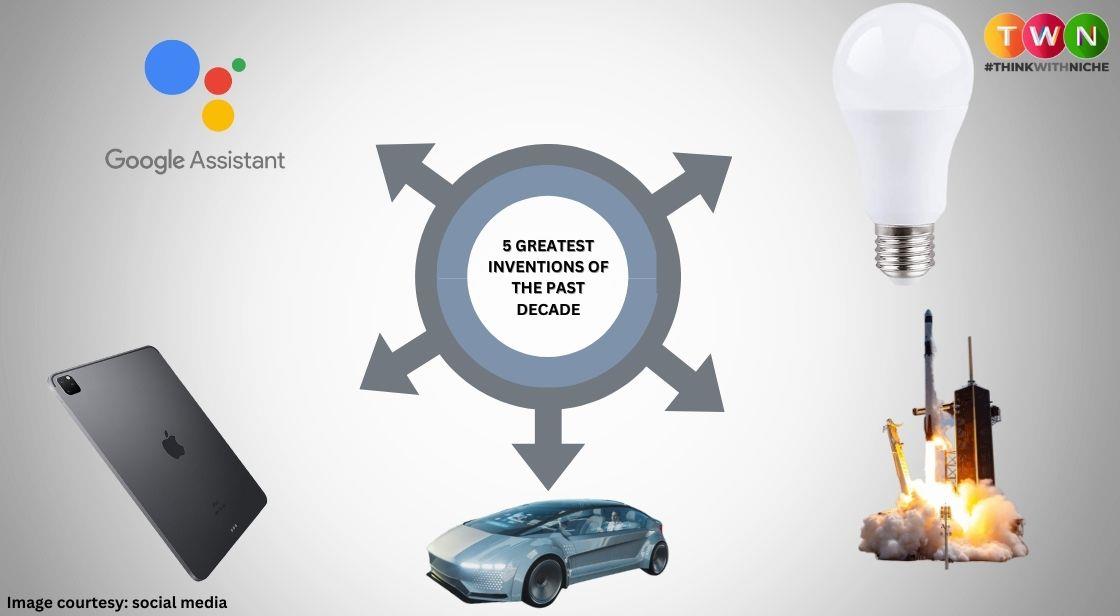5 Greatest Inventions Of The Past Decade

Blog Post
Because of life-changing inventions like the internet and the iPhone, the last 10 years have seen some of the most rapid technological breakthroughs in human history.
The internet revolutionized how we look for and share information with one another, hence breaking down communication barriers across countries. The iPhone transformed people's personal relationships with technology and information consumption, converting the smartphone from a luxury item to an essential everyday tool.
Understanding the internet's significance and the ongoing spread of information is critical as we investigate the Greatest Inventions Of The Past Decade
Table Of Contents:
- SpaceX Reusable Rocket
- How SpaceX has transformed spaceflight
- Google Assistant
- Google Assistant's birth and evolution
- The iPad's History
- Self-Driving Cars
- Advantages of Self-Driving Cars
- Consumer LED light bulbs
Innovations have always been definitive of a certain period in history. The influence of a particular discovery or innovation, be it in any field (technology, medicine, fashion, etc), gradually becomes a microcosm to define a whole period in history. That's how Volkswagen becomes a definitive commodity linked to the history of Germany and World War 2 and that's how Apple is mentioned during conversations about the post-2000s economy of a capitalist America.
As we are in a fresh decade (and stuck in a pandemic), all we can do is look at the past decade and judge the greatest innovation that dominated it. From the fast-moving technology in smartphones to new and advanced developments in artificial intelligence, the past decade is filled with great inventions and innovations. Let's have a look at 5 of the greatest inventions of the past decade.
Greatest Inventions Of The Past Decade
1. SpaceX Reusable Rocket
Since the creation of the V2 rocket in Germany in 1942, humans have been able to launch rockets into space. Manned space travel took another 19 years before cosmonaut Yuri Gargarin orbited the Earth successfully on April 12, 1961. The subsequent 'Space Race' between the United States and Russia sparked global interest in space travel, but the lack of reusable rocket technology has limited space flight to only the wealthiest nations.
Musk has stated that few believed it was possible at a time when space agencies dominated the business and space hardware was essentially disposable, with the exception of NASA's space shuttle and its solid rocket boosters.
One of the greatest inventions that we have ever experienced is the introduction of reusable rockets for space exploration. Elon Musk's space company, SpaceX, launched its Falcon 9 Rocket in the December of 2015 and created history as it went into outer space to deliver a payload and then landed back in a base camp in Cape Canaveral. Reusable rockets are perhaps one of the greatest inventions of this decade as it makes space exploration cheaper. Reusable rockets will also cause less destruction to the environment. Say what you will about Elon Musk, but the guy sure has great ideas cooking inside his head.
How SpaceX has transformed spaceflight
Musk has stated that in about 2002, he began examining NASA's plans to place humans on Mars and was astounded to find no established schedule. (In recent years, NASA has proposed the 2030s as a target date.) That's when Musk said he envisioned a Mars mission to spur the national will," according to Wired.
Meanwhile, Musk focused on building a reputation and securing contracts to launch satellites, International Space Station cargo, and humans closer to home. It took years to prove that SpaceX's reliability could compete with that of large companies like Arianespace and United Launch Alliance, but (as we'll see below) Musk's capacity to spend a lot of money testing reusable rocket technology assisted in that effort.
The SpaceX Falcon 9 is a two-stage rocket designed for human flight and payload delivery. Both the Falcon 9 and the larger heavy-lifter Falcon Heavy (which uses three Falcon 9 rocket boosters) are designed to return their lower rocket stages upright to Earth or to an ocean-based drone ship. Just before landing, four lightweight carbon fiber legs deploy, each with a shock-absorbing mechanism to cushion the impact.
The Space Shuttle period resulted in the creation of the ISS, making space flight considerably more accessible. More than 130 Shuttle missions were performed, however, the program never fulfilled NASA's optimistic 50-flight-per-year target, and individual launches cost an average of $450 million. In comparison, the Falcon Heavy could launch its maximum payload into low Earth orbit for $150 million, or one-third the expense.
Musk believes that once the Falcon 9 incorporates technology to make its second-stage rocket reusable, in addition to the first stage and its Dragon capsule, launches will be 100 times cheaper.
2. Google Assistant
Voice-based artificial intelligence, which was once the realm of science fiction, is now a reality. We're now at the stage where you can listen to the news, look up the weather, send a text message, and start watching a video about the best way to fold your socks without looking up from your morning cereal or touching a device, thanks to the help of A.I. like Alexa, Siri, and the Google Assistant. None is more integrated into Android than Google Assistant. It's in your phone, it might be in your living room, and it's ready to assist you when driving.
Google's artificial intelligence can be as helpful or as subtle as you want it to be. But it hasn't always been like this. In only a few short years, artificial intelligence has progressed from science fiction to an essential part of our daily lives — and in the case of Google Assistant, it has crept into our homes and lives without even upsetting the drapes.
Google Assistant's birth and evolution
Google Now changed the way we interacted with our phones, but Google Assistant was a glimpse into the future. Despite that grandiose claim, Google's Assistant originated as a little feature on Google's Allo messaging app. Its first function was to appear during chats when useful or when invited. It wasn't ideal, and Google was definitely keeping it separate from the rest of its services, but it was just the start. The development of Google Assistant was treated differently than everything else before it, as indicated by Google's employment of Google Doodle head Ryan Germick and ex-Pixar animator Emma Coats to give the Assistant more personality.
However, it wasn't long before Google Assistant broke free, first as a stand-alone feature on the original Google Pixel and the Google Home, then making its way to other smartphones running Android 6.0 Marshmallow and above in 2017. This was most likely the first time we saw the modern Assistant, with an interface that could be accessed via the Home button and the capacity to respond in a more conversational approach.
We'd be remiss if we didn't highlight Google Assistant's impact on smart speakers. The Google Home, which debuted alongside the Google Assistant at Google I/O 2016, was the first smart speaker to incorporate Google's Assistant, but it wasn't the last.
Also Read: Contributions Of The World's Richest People To Fight Climate Change
3. Ipad
Apple has always been at the forefront of bringing revolutionary tech. One such product is the iPad. iPad, launched in 2010, was laughed at by people who found its size funny. Neither a phone nor a laptop, iPads fell somewhere in between which wasn't acceptable by quite many people. But soon they would be proved wrong by its compatibility. Now Apple has successfully sold more than 400 million units and has greatly influenced the tech world. Next time you go to the supermarket, notice the screen at the cashier. That's the kind of influence iPads have had.
The iPad's History
Long before the iPad, Apple was experimenting with tablets. Its Newton MessagePad PDAs, which first appeared in 1993, were certainly tablet-like, albeit rudimentary by modern standards, with restricted apps, black-and-white displays, and complete reliance on a stylus. The PenLite, a more powerful PowerBook-based tablet, was also prototyped but never released.
Work on the iPad began in 2004 when designer Jonathan Ive and others created a revolutionary tablet prototype. The product was scheduled to be released before the iPhone, but the firm decided the latter was more vital and launched it in 2007 utilizing comparable technologies.
Following the success of the iPhone, rumors about tablet plans circulated, with conflicting predictions about what the product would be called and what it may perform. Finally, on January 27, 2010, Apple CEO Steve Jobs unveiled the iPad at the Yerba Buena Center in San Francisco, sparking both excitement and scepticism.
In the earlier half of this decade, Google and Apple covertly began developing completely autonomous cars. Most major automakers, as well as ride-hailing businesses such as Uber and Lyft, have already followed suit, and passengers may now hail driverless cabs being tested in locations such as Phoenix and Pittsburgh.
4. Self-Driving Cars
It seems a utopian concept but that's where we are living in. The concept of self-driving cars became popular post-2012 and soon every major AI company began working on developing this technology. The likes of Apple, Google, and Tesla developed their own versions of AI cars that could drive on their own. Soon this concept was adopted by ride-hailing companies such as Uber and Lyft. Many cities are experiencing the beta test phase of driverless cars. It won't be long before they begin to enter the mainstream market.
Advantages of Self-Driving Cars
Safety
The economic costs of motor vehicle accidents are truly astonishing. Of course, there are immediate costs to the automobiles involved, as well as any other property damage. There is lost time and productivity as a result of injury and incapacity to go to and from work, as well as the unavoidable spike in medical and vehicle insurance premiums, which is passed on to all consumers as the number of claims increases. Then there's the unquantifiable agony and suffering caused by driving-related injuries or death.
Drone cars would be resistant to driver error and fatigue. There would be no road rage-related incidents, no running red lights, and no issues with drivers texting or experiencing the effects of too much drinking. In short, the system would be virtually flawless and would be the safest way to go from one point to another. The societal financial benefits would soon recoup all of the money invested in the system's research and development, as well as providing enormous peace of mind.
Efficiency
This may be quantified in a variety of ways, but an automated system would be able to coordinate the movement of thousands, if not millions, of individual cars to ensure the lowest possible commute time as well as the most efficient use of resources for each mile traveled. A standard gasoline engine is most inefficient when it is forced to accelerate or brake unnecessarily, so a steady flow of vehicles that are not subject to random starts and stops and stay precisely within the boundaries of the posted speed limit will be the most efficient of all possible scenarios - and it will greatly reduce wear and tear on the cars themselves, further lowering costs.
Convenience
Most commuters spend a significant portion of their life trapped in traffic, which is not only exhausting but also wastes a significant amount of time that could otherwise be employed productively.
Imagine instead that the car is driving for you, freeing up your time to get a head start on the day's emails, practice your Chinese (you know you should!), or even get some rest. Also, when we drive back and forth on the same road on a regular basis, we rarely get a chance to look around and see anything other than the car. A self-driving automobile could allow us to enjoy the experience much more.
Accessibility
Driving a car at particular times and for specific persons is either inadvisable, illegal, or both for a variety of reasons. Is it possible for functioning individuals to be independent and mobile despite experiencing some physical restrictions due to age or illness? In other circumstances, licenses may be temporarily suspended, prohibiting breadwinners from financially supporting themselves and their families since they are unable to get to work. Too often, the economic hardship that comes with not being allowed to drive exacerbates the same tensions that led to the initial suspension, resulting in a cascade of social problems that we must all bear.
5. Consumer LED light bulbs
LED light bulbs have become a common thing in almost every household for the simple reason that they consume less energy, emit brighter light, cost less, and last longer. Compare this to the old incandescent bulbs that used 90% of the energy generated. Now that's a revolutionary figure. Now companies like Philips develop LED bulbs for everyday use that can last up to 25,000 hours.
LED lighting innovation
LED lights, like many other areas of technology, have evolved over time. They are unquestionably our favorite lighting option at Evergreen Energy, not least because of their sustainability. LED lights consume the least amount of energy and have the longest lifespan of any bulb on the market, making them a more environmentally friendly choice.
The most exciting aspect of LED bulbs is not only their adaptability, as they can be used in almost any part of the house, giving everything from bright lights in bathrooms to mood lighting in hallways. LED lights will continue to evolve as technology advances. They have the potential to become even more sustainable, energy-efficient, and user-friendly.
You May Like
EDITOR’S CHOICE












